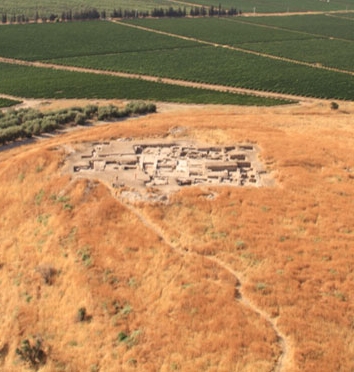HOME / Table of Contents = Civilizations - Cultures - Areas - Regions - Prehistory
Other Archaeological Sites / The Neolithic of the Levant (500 Page Book Online)
Ancient Kadesh

Ancient Kadesh is a tell site on the River Orontes southwest of Homs in Syria. Occupied from the 3rd millennium BC it is best known as the site of a battle between the Egyptians under Ramses II and the Hittites in 1286 BC. The outcome seems to have been inconclusive; the Egyptians claimed victory but if anything the battle may have favoured the Hittites and facilitated peace between the two nations ... (AHSFC).
Tel Kadesh is about 22 miles north of Tiberias. It was first occupied during the Bronze and Iron Ages then again in the Hellenistic and Roman periods. In the Bible Joshua names Kadesh as a city of refuge for those who accidentally cause the death of another (Joshua 20:7). According to 1 Maccabees 11:73 it was the site of a siege during the rise of the Hasmoneans and Josephus writes about Kadesh in Antiquities of the Jews and The Jewish War. Past finds include a house with objects strewn about the floor, apparently abandoned during the battle between Jonathan the Hasmonean and the Seleucid King Demetrius. Excavators discovered a cache of nearly 2000 Hellenistic bullae in the corner of an enormous building, likely an administrative archive. Also unearthed was destruction debris associated with the battle between Jonathan and Demetrius.
The Battle of Kadesh

 (1275 BC): major battle between the Egyptians under Ramses II and the Hittites under Muwatallis in Syria southwest of Homs on the Orontes River. Seeking to recapture the Hittite held city of Kadesh in Syria Ramses II invaded Syria with four divisions and an auxiliary force. Muwatallis gathered a large alliance among his vassal states and, hiding his army behind the city mound, sent out false reports that he was at Aleppo farther north. Ramses, falling into the trap, hurried his army toward Kadesh, his units stretched along the Orontes Valley road. Toward evening Ramses II with the first division reached Kadesh and set up camp. Too late, two captured Hittite scouts confessed the actual situation. The Hittites forded the river and after routing the second division, stormed the Egyptian camp. His first division destroyed, Ramses was saved mostly by his auxiliary force that struck the attacking Hittites in the rear. Pushing the Hittites into the river, the mauled Egyptians retained the battlefield. The next day after indecisive fighting Ramses was compelled to withdraw his battered army; and in the aftermath the Hittites advanced south to the region of Damascus, halting the Egyptian resurgence into Syria. The biased Egyptian version of the battle was recorded on numerous temples by Ramses but a Hittite version excavated at Boghazköy has enabled a truer assessment of the battle ...
(1275 BC): major battle between the Egyptians under Ramses II and the Hittites under Muwatallis in Syria southwest of Homs on the Orontes River. Seeking to recapture the Hittite held city of Kadesh in Syria Ramses II invaded Syria with four divisions and an auxiliary force. Muwatallis gathered a large alliance among his vassal states and, hiding his army behind the city mound, sent out false reports that he was at Aleppo farther north. Ramses, falling into the trap, hurried his army toward Kadesh, his units stretched along the Orontes Valley road. Toward evening Ramses II with the first division reached Kadesh and set up camp. Too late, two captured Hittite scouts confessed the actual situation. The Hittites forded the river and after routing the second division, stormed the Egyptian camp. His first division destroyed, Ramses was saved mostly by his auxiliary force that struck the attacking Hittites in the rear. Pushing the Hittites into the river, the mauled Egyptians retained the battlefield. The next day after indecisive fighting Ramses was compelled to withdraw his battered army; and in the aftermath the Hittites advanced south to the region of Damascus, halting the Egyptian resurgence into Syria. The biased Egyptian version of the battle was recorded on numerous temples by Ramses but a Hittite version excavated at Boghazköy has enabled a truer assessment of the battle ...
The History of the Ancient Near East Electronic Compendium

